| About Hubei | Culture & Arts | ||
| Attractions | Routes | ||
| Dining | Shopping | ||
| Hotels | Transportation | ||
| Entertainment | Travel agencies |
Jingshan to attract Wuhan tourists
Storytelling queen
For the love of Wuhan
Dangyang to promote tourism


Qingjiang River Art Gallery
(myyangtzecruise.com, chinadaily.com.cn)
Updated: 2011-12-12
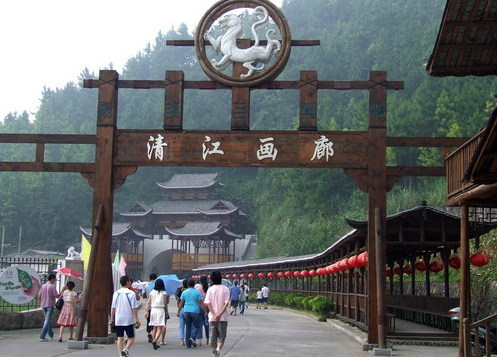 |
| Entrance of the Qingjiang River Art Gallery (photo from nipic.com) |
The Qingjiang River Art Gallery is located in Changyang Tujia Ethni Group Autonomous County of Yichang. It includes all the scenic spots between Geheyan Dam and Yanchi Spring along the Qingjiang River. It is a provincial-level scenic area and holiday resort in the Hubei province. It is also a national forest park approved by the National Forestry Bureau and one of the AAAA-class scenic areas named by the Tourism Administration of Hubei province.
Qingjiang River originates from Longdonggou of Lichuan city in western Hubei province. It flows through Enshi county, Changyang county, Badong county and pours into Yangtze River at Yidu. It stretches 423 kilometers and is about 148 kilometers long. There is an old saying goes that the “800-li (Li is a unit of length equal to 0.5 kilometers) Qingjiang River is as beautiful as a painting.” The Geheyan Dam, constructed in 1994, is 11 kilometers away from the county seat. The dam is 165 meters long and 150 meters high and prevents flooding while storing water and generating electric energy.
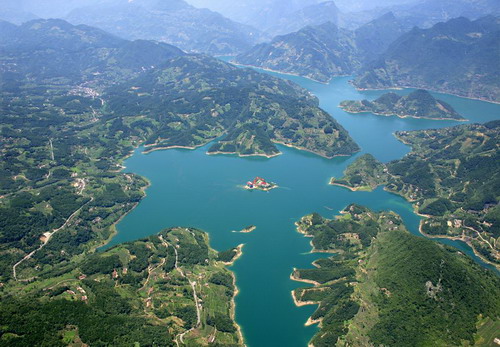 |
|
"The 800-li Qingjiang River is as beautiful as a painting and the 300-li Qingjiang River in Changyang county is an art gallery.” |
Landscape
"The 800-li Qingjiang River is as beautiful as a painting and the 300-li Qingjiang River in Changyang county is an art gallery.” Qingjiang River has been praised with as a lyrical poetry, graceful songs and pleasant paintings. There are peaks covered with dense forests on both banks in the 300-li Qingjiang River Art Gallery scenic area. Visitors say that Qingjiang River Art Gallery is as magnificent as the Three Gorges, as clean as Lijiang River in Guilin city and as beautiful as the West Lake in Hangzhou city. Qingjiang River was also admired as the Oriental Danube.
Attractions
Visitors are able to tour Baidao Lake (A Hundred Islands Lake) by ship from the Geheyan Dam. Baidao Lake is located at the upper reaches of Geheyan Reservoir. There were some mountains that tower over both banks of the river. After the construction of Geheyan Dam, the water level raised dozens of meters and the mountains became islands in the river, hence it was named Baidao Lake. Visitors may tour Daoying Gorge (Reflection Gorge), Baiyu Lake (White Jade Lake), Baiyuan Lake, Wuluozhongli Mountain, Tianzhu Mountain and Ba People Cave.
Wuluo Zhongli Mountain is an integration of Wuluo Mountain and Zhongli Mountain. It is 300 meters high and 30 kilometers away from Longzhouping. It takes an hour to sail from the docks to the foot of the mountain. The mountain is low but steep and according to historical records, it was the cradle land for the Tujia ethnic minority. The summit of the mountain contains Kuitou Rock, Niujiao Rock, Yannv Rock, Shishen Platform and Miaotu Rock. The Niujiao Rock towers aloft solitarily, like an ox horn. The Yannv Rock is said to be an incarnation of the saline water goddess. A small temple was built upon the Shishen Platform with offerings for the stone god. The Miaotu Rock hangs in the air and the Xiangwang Temple is built upon the rock. The mountain side has two stone caves, one red and the other dark. According to Commentary on the Waterways, it was the birthplace of ancestors of Tujia ethnic minority.
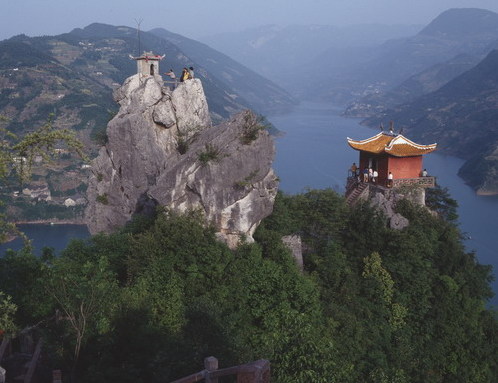 |
|
Wuluo Zhongli Mountain is an integration of Wuluo Mountain and Zhongli Mountain. (photo from nipic.com) |
Tianzhu Mountain is located in the northern bank of Qingjiang River, 34 kilometers to the west of the seat of Changyang county. Since a Taoist temple was constructed there in Tang Dynasty, the mountain has become one of the cradles of Chinese Taoism. It is just as famous as Wudang Mountain named the supreme headquarters of Taoism. Tianzhu Mountain, 1,445 meters above the sea, features lofty dripstones and towering isolated peaks. The summit is flat with a clear spring flowing ceaselessly all the year round. The mountain has three 130-meter-high peaks at the summit. They stand side by side at a distance of only four meters. The three peaks are connected with two bridges. They present a splendid sight, as if stone pillars support the sky. The mountain has magnificent ancient buildings. In addition to the Taoist Temple of Tang Dynasty, it has the Earth Mother Temple, Three Emperor Temple, Lingguan Hall, Jade Emperor Pavilion, Yuxu Palace, and Nanyan Palace built in the reign of Emperor Tongzhi of Qing Dynasty. Tourists may climb more than 1,000 stone steps to reach the temples.
Danshui River, a branch of Qingjiang River, is known for its limpid shallow water that reveals stone riprap over the riverbed. It is lined with undulating luxuriantly green mountains at both sides, an ideal destination for a drifting tour. The river is a dozen meters at the widest and four meters at the narrowest. The best time to try drifting is after a heavy rain, when the water yield becomes great and the water rushes fast. Two to three people may embark on a gas-filled leather raft and float downstream at the upper course. In the sections of wide water and slow currents, people may paddle the raft, look up to the secluded scenes along the banks or search for small fish and crabs at the bottom of the river. When it comes to the narrower sections, the stream is obstructed by stones, causing waves to splash onto the raft. One must be careful when steering the leather raft otherwise it may dash against larger stones. Experiencing the rushing torrents is exciting for people who live in the city and is quite different from the rafting in the Lesser Three Gorges and Shennong Stream. In the Lesser Three Gorges, tourists are on board motor vessels with engine noises making it difficult to calm the mind and enjoy the magnificent landscapes. In Shennong Stream, the flat bean shaped wooden boats are towed by boat trackers to the upstream and boaters pole the boats on the drift. Tourists may enjoy the serene mountains and clear waters but they have no opportunity to personally sail a raft against the tide.
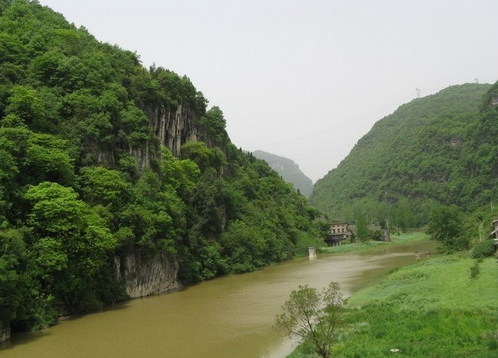 |
|
Danshui River is lined with undulating luxuriantly green mountains at both sides. (photo from nipic.com) |
Qingjiang river takes its rise in the mountain Qiyue and flows crossing more than 10 cities and countries from its source in Lichuan city to its mouth Changyang country. The whole length of Qingjiang River is about 400km, including 148km in Changyang ethnic minority autonomous country.
The character Qing in Qingjiang River means clear and pure in Chinese, according to commentary on the waterway’s classic written by the famous geographer in the Yuan dynasty. The Qingjiang River is so clear that one can see the sand and stones about a hundred feet deep under water.
The crystal-clear Qingjiang River looks like a blue ribbon going through the mountains and gorges. Qingjiang River not only posses a charming sight but also has a profound Ba culture. It is the birthplace of Tujia people who live in the Changyang country, Jianshi country and Lichuan country along the river.
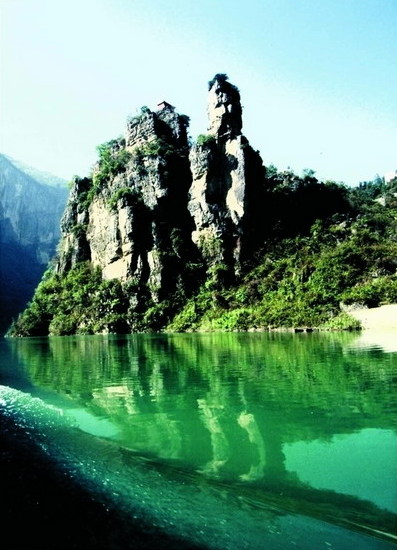 |
|
The crystal-clear Qingjiang River looks like a blue ribbon going through the mountains and gorges. (photo from nipic.com) |
There is a Xiangwang King temple. It is said to be the Bin Jun lord that explored the Qiangjiang River. As a result, people respected him as the Xiangwang king and built this temple for him. The formed temple was burned during the anti Japan war period and this one was rebuilt by government in 1984.
The Xiangwang temple is the center of Wuluozhongli mountain, which is the main place for people to pilgrimage the Lin Jun lord.
In the legend, there were five families among the ancestors, the Ba, the Fan, the Qin, the Xiang and the Zheng. The leader of the five tribes was determined by matches. The first match was to throw sword as far as possible and the second match was to ship an earth boat out with the furthest one being the winner. Lin Jun lord won both matches so the leadership belonged to Lin Jun lord. There is a couplet hanging on the columns of the hall that tells us the story of those matches.
On the opposite side is the stone god platform. On its top, there is a small temple facing the dragon-horn mountain. In this temple, there are two cobbles of male and female shape, which show you the Phallism of the Tujia ancestors.
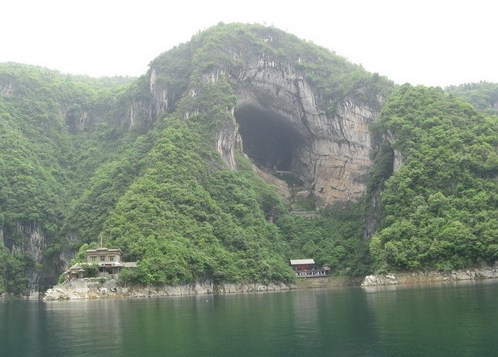 |
|
The whole length of Qingjiang River is about 400km. (photo from nipic.com) |